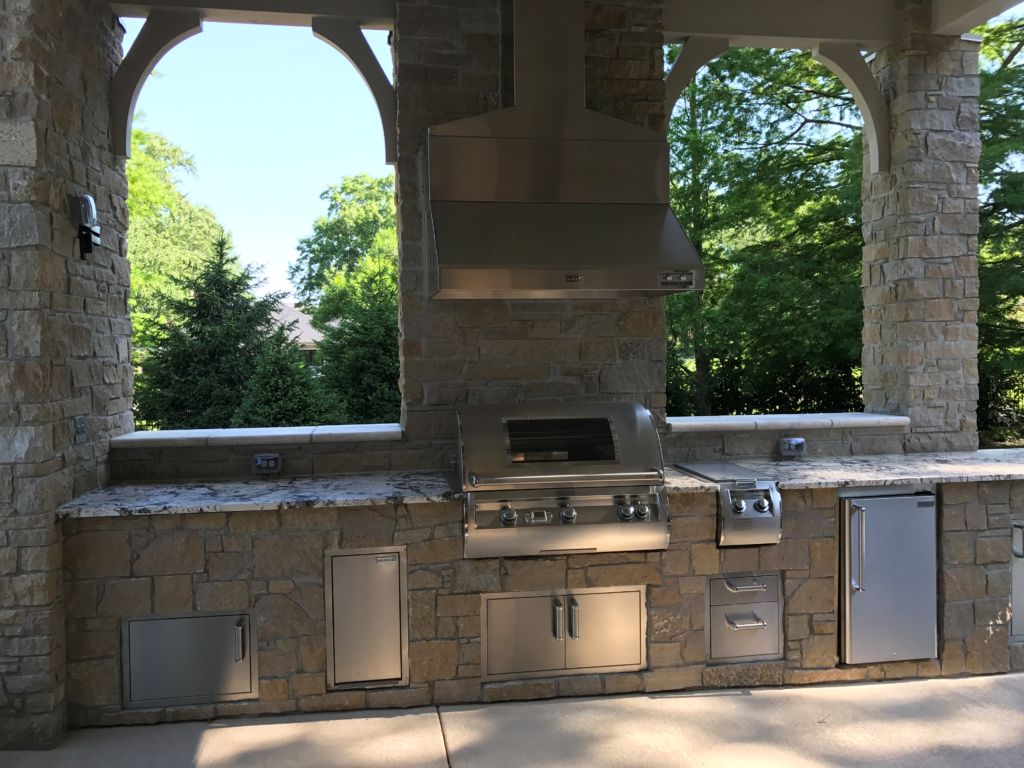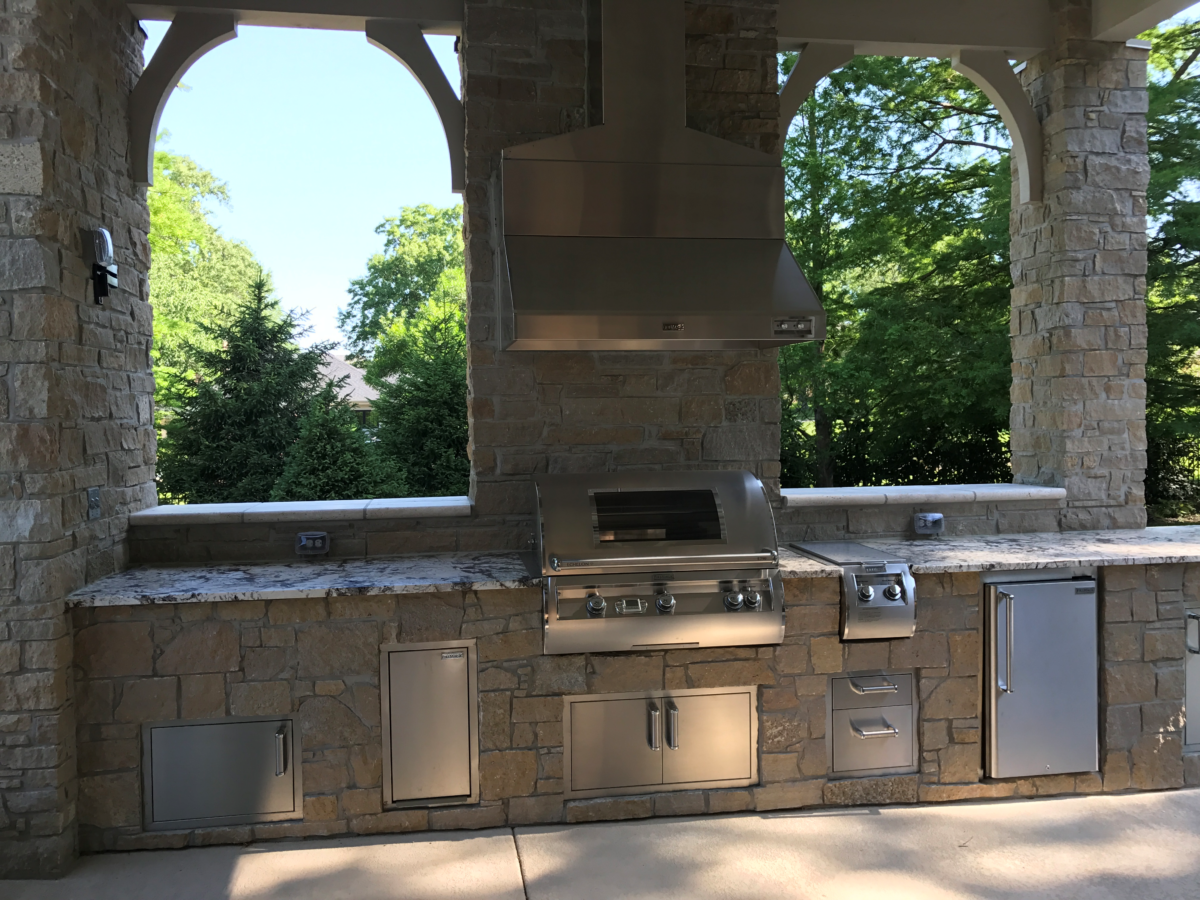Adding an outdoor kitchen to your home is a great way to enhance your outdoor space. You’ll enjoy cooking dinner on beautiful spring, summer, and fall evenings at the twilight hour. You can add refrigeration to keep drinks cold for long days outside by the pool in the summer too. The possibilities are endless, and it can be a little overwhelming to make so many decisions! We’re here to help you. We’ve built hundreds of outdoor kitchens ranging from a single grill station to an ornate expansive kitchen with multiple built-in firepits and grills. We’re the most experienced turn-key outdoor kitchen retailer in St. Louis, so you can sit back and relax while we make your space great!

Cooking is the cornerstone of outdoor kitchens
Yes, this might sound dumb to say that cooking is the raison d’etre for a kitchen, but there are a lot of different ways to cook outdoors. We have gas grills, pellet grills, charcoal smokers, ceramic grills, power burners, griddles, and pizza ovens. No matter what you decide for your cooking appliance, you’ll want to pick that first. All outdoor cooking appliances get extremely hot and have clearances to back walls and overhead construction that we need to consider. As in the photo above, nearly every grill requires a hood when installed under a wood or vinyl (combustible) roof.
The most common choice for outdoor cooking is a gas grill, sideburner, and ceramic charcoal grill (Big Green Egg). This gives you a huge range in what you can cook outside. The grill is great for everyday use when you need it to heat up quickly and don’t have time to light and wait for a charcoal fire. We have a wide range of gas grills to choose from. Grills come in a huge range of sizes from 48″ to 24″. Typically, 36″ and 30″ grills are most common. A 36″ grill will give you enough space to cook for 12-18 people and a 30″ will work for 6-10. Another important thing to consider when you are adding a built-in gas grill is that you want to buy something that will hold up for a long time. If you buy a cheap grill, you’ll probably end up spending more later to retrofit something to your kitchen because no two grills have the same rough opening dimensions (we usually have to fabricate stainless steel trim panels when we do this kind of swap).
Sideburners range in size from 15,000 to 60,000 BTUs, so these can either be as simple as a place to boil some water for pasta, or big enough to cook lobster.
If you have the space, a ceramic charcoal grill is a great addition to an outdoor kitchen. These aren’t typically that expensive (~$1000-1500 depending on the size), but they give you an incredible amount of cooking versatility. You can cook pizza, ribs, brisket, and also grill steaks and veggies too. Often, our clients think they want a big pizza oven (which we do sell and these can be great), but for 1/3 the cost, you can get something that does everything a dedicated pizza oven does, plus more.
Pizza ovens and griddles are two cooking appliances that have become more popular recently. We generally recommend pizza ovens that sit flat on the countertop. These are easy to install (and move if you decide to change where it sits on the counter), and they look great. Often, our clients don’t realize the range in dishes you can cook in a pizza oven. These are available in both wood and gas versions, but wood are more commonly sold. Using a pizza oven is part of entertaining; it’s fun to light a fire and serve appetizers when they’re fresh from the oven. Pizza ovens do take some work, though, so we often pair them with an “everyday” cooking appliance like a gas grill. Griddles have become popular recently. We have both built-in dedicated griddles as well as griddle accessories that can be put into a grill or onto a sideburner. Generally, we think the accessory route is a better option for most people (it’s less expensive and more flexible), but if you’re a die-hard griddle fan (we know you’re out there), then we have some high-quality options for built-in stainless steel griddles that will last basically as long as you want to use them.
Adding the right doors, drawers, and refrigeration will make your kitchen 😙👌
Once you know what cooking appliances you’ll need, it’s time to decide what doors, drawers, and refrigeration you’ll want. There are a few basic must-haves: you’ll need a door under each grill so that you can reach the gas emergency shutoff and transformer, and you’ll probably want a door under each sink so you can get to the plumbing (more on sinks later). Besides that, most of our clients do the same things: a three drawer stack next to the grill, trash can, and then whatever other storage they need. There are two main types of door/drawer kits out there: 1) the front door frame only 2) a door or drawer with a sealed frame behind it. Note that sealed frame does not equal weathertight or waterproof (unless a manufacturer explicitly says something is waterproof, it is not). That said, most of the doors and drawers we sell do stay incredibly dry and really only get wet in really insane applications. Your door and drawer layout will depend mostly on your space and budget. Door frame only kits are less expensive, but you’ll have to finish the inside of your structure, so often our clients prefer to buy a kit with the sealed frame/shell behind it. You want to make sure you have enough storage for what you need, but you also want to not overload the kitchen with too many doors and drawers. These are different than indoor cabinets; because most outdoor kitchens are finished with stone, you want to leave enough space to see the stone. Having 2-4″ of stone between each door and drawer doesn’t look good; it’s better to leave some room and let the whole kitchen become a blend of stone and stainless steel in equal balance.
Not all refrigerators are created equal. There is a big difference between “outdoor rated” and not outdoor rated refrigerators. “Outdoor rated” ones will be 3-5x more expensive and will actually be built for use in an outdoor kitchen. You may be able to install a normal refrigerator outside, but we typically see these fail within two or three years. Outdoor rated refrigerators have strong warranties, and we rarely receive calls that they have stopped working. We sell refrigerators most often when a client has a pool area; it’s very helpful with keeping kids outside when they have wet swimsuits on. Even if you don’t have a pool, it’s nice to have the outdoor fridge stocked when guests arrive. Every outdoor rated refrigerator we sell will work without issue during hot St. Louis summers. Really the only maintenance you have to do is turn it off in the winter and take your drinks out so they don’t freeze.
Keep the fire in the grill; let’s build your kitchen safely
Building an outdoor kitchen isn’t hard if you now what you’re doing. Don’t treat the structure as an afterthought. When we build outdoor kitchens, we use galvanized steel studs (heavy ones we have custom rolled; not your average hardware store fare), Permabase brand cement board, and special galvanized fasteners. We’ve had the design evaluated by an outside structural engineering company, and we have decades of experience with real world work across the country to make sure our design is practical. Our approach makes the outdoor kitchen construction process faster and simpler. Our kitchen modules arrive to your patio with the cutouts and sidewalls already installed, so all that is needed is attaching them together and installing the doors, drawers, grills, etc. Depending on the size, we can typically set a kitchen in a few hours. Our structures are completely non-combustible, so you don’t need to worry about your kitchen catching fire when you’re using it. Once the kitchen is set, you can use real or man-made stone, stucco, brick, or tile to cover the structure. This kind of construction gives you ease of installation while not compromising on the final fit and finish of your project. Our open frame design also gives plenty of room in the interior of the structure for locating gas lines, electrical boxes, and plumbing. Your other trades will do your job faster because it’ll be easier to work with our structure. It’s also easier to fix something if it breaks in the future.
Besides our modular system, there are a few other acceptable ways to build an outdoor kitchen. A mason can build the structure out of block or brick. This approach ensures a non-combustible construction, but it can be slow and create more of a mess on the jobsite. Completely finished metal cabinets are also an option. These come in a range of styles and colors and are typically much more expensive than building a kitchen from masonry.
You should definitely not build a kitchen from combustible materials. This includes wood, vinyl, pvc, or anything else that will burn when exposed to heat. You also cannot make the guts out of wood and clad it with stone; the wood framing will catch fire and burn at some point. If you have to use one of these materials, some vendors make insulating jackets for grills which enable some reduced clearances. You should be careful when working with these to make sure you install them properly. We recommend staying completely clear of combustible structures to ensure long-term safety.
Your kitchen also needs to have adequate ventilation. We ventilate the ends of our cabinets to ensure enough air gets into the structure. This does two things: 1) prevents excessive moisture build-up 2) prevents unburned gas from building up inside the structure. Each grill manufacturer will recommend or require ventilation on at least two sides of the kitchen to prevent the island exploding if there is a gas leak.
Finishing your kitchen: customize your look
Once you have your kitchen built, then it’s time to apply the finish. There is a huge variety of finishes available and there is no right or wrong answer on what to use (other than it must be non-combustible, see above). We typically install stone veneer. This can be “drystacked” (meaning there are no mortar joints showing), or it can be set with a mortar joint. We generally recommend using thin-cut stone (1-2.5″ thick) because it is typically more cost-effective to lay this over our modular structure than full dimension stone. We sell a huge variety of styles and colors, so it’s easy to find something that coordinates well with your space. If you want to match your home, that is possible too (provided the material is still available). We will often set the kitchen, granite top, and appliances and let the client supply their own finish. The possibilities are endless with stone, tile, brick, or stucco.
We always recommend granite for countertops. We’re often asked about man-made materials like quartz, but granite is the only material that will hold up outside. Lesser materials are not treated for constant UV exposure or the freeze/thaw cycle and can often yellow, flake, or pop out of the mortar setting bed. Granite is non-combustible and heat-resistant, so having a hot grill against it won’t cause a problem. Granite comes in a range of colors, and we try to recommend one that won’t get excessively hot in the sun (dark colors get pretty hot). We typically recommend a simple eased edge, since this will result in as little water in drawers as possible (other edges like bullnoses can make water drip into drawers). We can do almost any edge you want, but outdoors, simplest is best. Our in-house fabrication team will work with you to pick the right color; we have extensive experience picking colors that coordinate well with your home.
So, talk to me about getting a sink out there
We get asked about sinks and having water in outdoor kitchens all. the. time. It’s a great amenity, but it’s typically cost-prohibitive. When we’re adding an outdoor kitchen, it’s pretty straightforward to trench through the yard to add a gas line (sometimes there’s even an old grill with one already there). Electrical can be tougher, but generally is like a gas line: dig a trench and lay conduit to the kitchen. Plumbing is more difficult. You’ll need to pull water (both hot and cold if you’re so inclined) and run that through a trench into the kitchen structure. You’ll also need a drain that goes back from your kitchen into your main sewer system for your home. No, you cannot drain it into your yard. And yes, we do see people do that. Typically, after clients price the water & drainage work, that’s the first thing to be removed as we work through their budget. Obviously, if you’re doing a larger project where the labor is within the existing scope, it’s a totally different discussion, but for adding a kitchen to your home with an existing patio, we rarely do it.
Yeah ventilation sucks, we know
If you have your grill under a combustible roof, you’re going to need a hood. Period. End of story. We have many clients who come to us with plans with a grill under a combustible roof without a hood drawn in and we have to break the news to them that they will need to spend another ~$5k to add a hood to their appliance package. Yes of course you can install anything anywhere in your home (you can probably park your car in your living room if you want…no judgement here). It just won’t be safe. And we don’t install appliances against what the manufacturer recommends. Every manufacturer requires hoods to be in place below a combustible roof. There is pretty good experience and reasoning behind this. As you use your grill, smoke and grease will settle onto the surface of your roof. Over time, this layer gets thicker and wider, and creates an area with a much lower flash point (that is, with a lower temperature where fire will start). Let’s say you walk out with a bowl of veggies with olive oil on them and toss them onto your grill that you haven’t cleaned in a few months. A 6-foot tall grease fire erupts briefly and then catches your roof on fire, and then the next call is to the fire department, hopefully before your house burns down. A vent hood sucks all the grease and smoke and pushes it out from under the roof. Yes, they are expensive and yes, they do make noise. But when you think about how gross your area will smell when all the years of accumulated grease are sitting on the underside of your roof, AND there’s a safety hazard sitting there waiting for you, the vent hood becomes a no brainer. At least we think so.
Hopefully this guide has been helpful to you. We’re here to help you design an area that will be beautiful, durable, and safe. Please reach out to us via email or give us a phone call for a consultation about your outdoor kitchen dreams and let us get to work turning them into reality!
Previous Next

